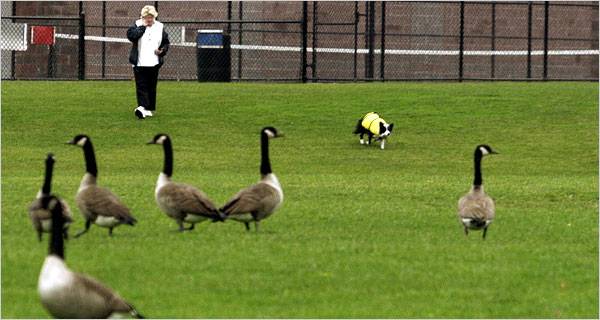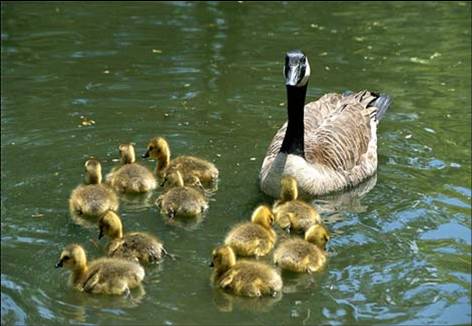GeesePeace In 1998, Lake Barcroft, Virginia found itself in a predicament. The small community of 8906 residents was overwhelmed by Canada geese nesting on their lawns and along the banks of the lake. As a nature loving community, neighbors were uncertain how to handle management at a time when hunting or a lethal round-up were the most common methods of management. Together the community decided they preferred a more humane management strategy and developed the 17-point plan that would eventually be known as GeesePeace. This plan included use of a trained border collie to flush the geese, community education, addling of goose eggs to reduce viablility, habitat modification, and other humane tactics. Based on this, Lake Barcroft was the first community in the country to receive a permit for egg addling (required by the Migratory Bird Treaty Act). Also critical to the Lake Barcroft plan, was the goal not to move the geese to neighboring towns. Humane management methods were especially effective in this situation, as the town was welcoming of alternatives to the norm, and was generally unconcerned about cost. At the end of the day, I would be interested to learn if the residents truly reached their objectives and if they were actually able to keep their geese from moving to a neighboring town. It is critical in this case to consider what is best for the geese, and if this is part of the objective of the town. I believe that Lake Barcroft took this objective to heart, and built a plan around it. (http://www.lakebarcroft.org/index.html, www.geesepeace.org)
|
|
 |
 |
Braintree, Massachusetts Braintree, Massachusetts, a south-shore town of about 33,828 residents began to feel the weight of resident Canada geese a little over ten years ago, when they made the town’s golf course their home. Since 1995, Braintree has lifted the ban on Canada goose hunting for a brief season in order to reduce their population. Many city residents disagree with this tactic, however, the city claims that they once attempted the humane management tactic of using a border collie, but it was ineffective. The story in Braintree is neither new nor unique. Many towns across the country feel overwhelmed by geese, and have lost use of an important town resource. Often times hunting is the management method of choice because it is inexpensive, and simple to implement. Unfortunately it is only effective for a single season, which is why Braintree must repeat its hunt annually. The single attempt of a humane and sustainable management tactic (border collie) is also not uncommon. Often times a town will engage a company which claims a tactic is a cure-all, and not explain how it must be used with other tactics, and repeated. This type of engagement with humane management can turn a town off from further exploration of such tactics. There are a couple major problems with Braintree’s management approach. First, they repeatedly kill geese, with little consideration for the population’s dynamics. Secondly, they do not seem to have a plan to reduce the movement of geese from Braintree to the next town over. I do not believe that hunting is inherently wrong, or a poor approach to wildlife management. I simply do not feel that it is compatible with Canada geese in this case. The town must seriously consider that their goose problem is not going away. It is remaining constant, and therefore might be considered ineffective in the long run. (Boston Globe, Patriot Ledger, Wikipedia) |
|
 |
|